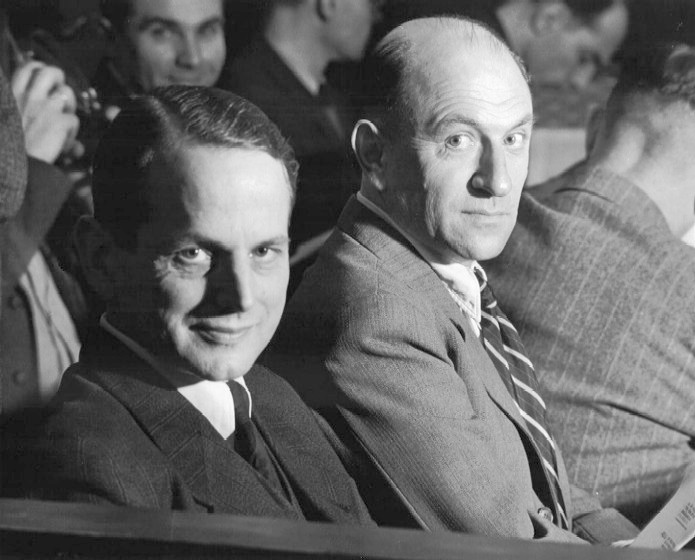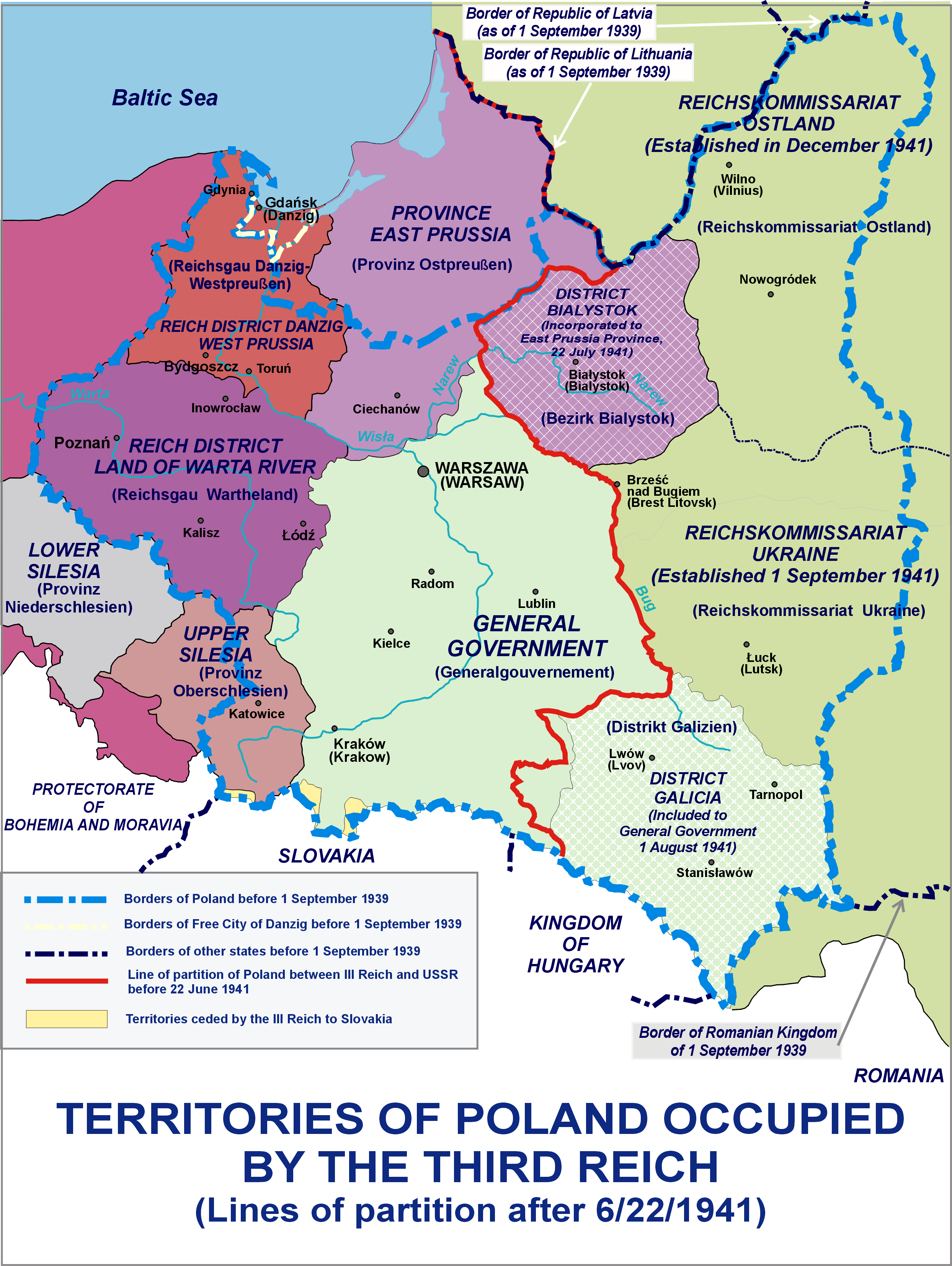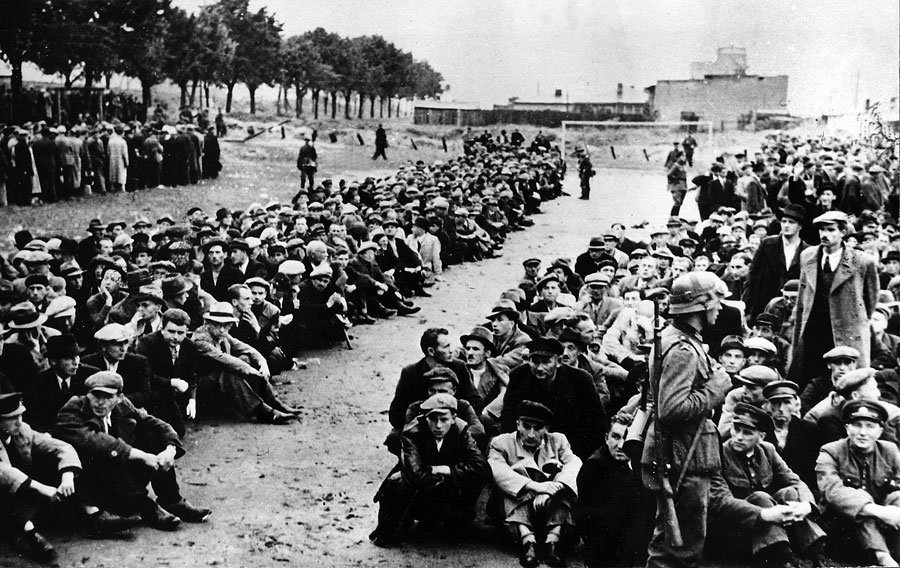|
Chief Of Civil Administration
Chief of Civil Administration () was an office introduced in Nazi Germany, operational during World War II. Its task was to administer civil issues according to occupation law, with the primary purpose being the support of the military command in the operational areas of the German Army. CdZ would pass his authority to a corresponding civil government after the territory in question became in the rear of the operating armed forces. Responsibility According to German law, all executive powers in the deployment areas passed to the Wehrmacht armed forces. Overstrained and incapable to construct a civil administration, the German Army High Command willingly put these tasks to the CdZ. In the capacity as ''Reichsstatthalter'' governor, the office was under the authority of the Reich Ministry of the Interior, but operationally CdZ was under the commander-in-chief of the German Army and ultimately of Adolf Hitler as supreme commander. Hitler generally interfered in the domestic policies ... [...More Info...] [...Related Items...] OR: [Wikipedia] [Google] [Baidu] |
Reichskommissar
(, rendered as "Commissioner of the Empire", "Reich Commissioner" or "Imperial Commissioner"), in German history, was an official governatorial title used for various public offices during the period of the German Empire and Nazi Germany. German Empire Domestic In the unified German Empire (after 1871), Reichskommissars were appointed to oversee special tasks. For instance, there was a Reichskommissar for emigration (''Reichskommissar für das Auswanderungswesen'') in Hamburg. Presumably the same title is rendered as "German Imperial Commissioner" in the case of Heligoland, a strategically located once-Danish island in the North Sea, formally handed over to Germany by the UK on 9 August 1890 (under the Heligoland–Zanzibar Treaty) and on 15 December 1890 formally annexed to Germany (after 18 February 1891 part of the Prussian province of Schleswig-Holstein): 9 August 1890 – 1891 Adolf Wermuth (b. 1855 – d. 1927) Colonial The title of ''Reichskommissar'' was used during ... [...More Info...] [...Related Items...] OR: [Wikipedia] [Google] [Baidu] |
Province Of East Prussia
East Prussia was a province of the Kingdom of Prussia from 1772 to 1829 and again from 1878 (with the Kingdom itself being part of the German Empire from 1871); following World War I it formed part of the Weimar Republic's Free State of Prussia, until 1945. Its capital city was Königsberg (present-day Kaliningrad). East Prussia was the main part of the region of Prussia along the southeastern Baltic Coast. The bulk of the ancestral lands of the Baltic Old Prussians were enclosed within East Prussia. During the 13th century, the native Prussians were conquered by the crusading Teutonic Knights. After the conquest the indigenous Balts were gradually converted to Christianity. Because of Germanization and colonisation over the following centuries, Germans became the dominant ethnic group, while Poles and Lithuanians formed sizeable minorities. From the 13th century, the region of Prussia was part of the monastic state of the Teutonic Knights. After the Second Peace of Thorn in 1 ... [...More Info...] [...Related Items...] OR: [Wikipedia] [Google] [Baidu] |
Zichenau (region)
''Regierungsbezirk Zichenau'' was a ''Regierungsbezirk'', or administrative region, of the Nazi German Province of East Prussia in 1939–45, established in German-occupied Polish territory during World War II. The regional capital was Zichenau (Ciechanów). It was also referred to under the designation of South East Prussia () which, however, was later sometimes also applied to Bialystok District, although the latter was not incorporated into, but merely attached to East Prussia. History The government region was created on 26 October 1939, out of Polish areas annexed by Nazi Germany during World War II. The region had an area of 12,000 km2 and a population of approximately 895,000, including 800,000 Poles, 80,000 Jews, and 15,000 Germans. The Polish population was subjected to various crimes, including mass arrests, roundups, deportations to forced labour and concentration camps (including teenagers), executions, massacres (also as part of the ''Intelligenzaktion'' an ... [...More Info...] [...Related Items...] OR: [Wikipedia] [Google] [Baidu] |
Heinz Jost
Heinz Jost (9 July 1904 – 12 November 1964) was a German SS functionary during the Nazi era. He was involved in espionage matters as the ''Sicherheitsdienst'' (Security Service) or (SD) section chief of office VI (foreign intelligence) of the Reich Security Main Office. Jost was responsible for genocide in eastern Europe as commander of ''Einsatzgruppe'' A from March–September 1942. After Germany's defeat, Jost was tried and convicted by a U.S. military court at the Einsatzgruppen trial. In December 1951, Jost was released from Landsberg Prison after his sentence was commuted to ten years and died in 1964. Early life Heinz Jost was born in the northern Hessian Homberg (Efze) - Ortsteil Holzhausen - in Hersfeld in 1904, to a middle-class Catholic and nationalistic family.The Nuremberg SS-Einsatzgruppen Trial, 1945-1958: Atrocity, Law, And History. Hilary Earl. Cambridge University Press, 2009. p. 115. Heinrich Jost, Heinz's father, was a pharmacist and later became ... [...More Info...] [...Related Items...] OR: [Wikipedia] [Google] [Baidu] |
Reichsgau Wartheland
The Reichsgau Wartheland (initially Reichsgau Posen, also Warthegau) was a Nazi Germany, Nazi German ''Reichsgau'' formed from parts of Second Polish Republic, Polish territory Polish areas annexed by Nazi Germany, annexed in 1939 during World War II. It comprised the region of Greater Poland and adjacent areas. Parts of ''Warthegau'' matched the similarly named Treaty of Versailles, pre-Versailles Prussian province of Posen. The name was initially derived from the capital city, Poznań, Posen (Poznań), and later from the main river, Warta River, Warthe (Warta). During the Partitions of Poland from 1793, the bulk of the area had been annexed by the Kingdom of Prussia until 1807 as South Prussia. From 1815 to 1849, the territory was within the autonomous Grand Duchy of Posen, which was the Province of Posen until Second Polish Republic, Poland was re-established in 1918–1919 following World War I. The area is currently the Greater Poland Voivodeship. Establishment and administra ... [...More Info...] [...Related Items...] OR: [Wikipedia] [Google] [Baidu] |
Arthur Greiser
Arthur Karl Greiser (22 January 1897 – 21 July 1946) was a German Nazi Party politician, SS-''Obergruppenführer'', ''Gauleiter'' and ''Reichsstatthalter'' (Reich Governor) of the German-occupied territory of ''Wartheland''. He was one of the persons primarily responsible for organizing the Holocaust in occupied Poland and numerous other crimes against humanity. He was arrested by the Americans in 1945, and was tried, convicted and executed by hanging in Poland in 1946 for his crimes, most notably genocide. Early life and career Greiser was born in Schroda (Środa Wielkopolska), Province of Posen, Imperial Germany, the son of a minor local bailiff (''Gerichtsvollzieher''). He learned to speak Polish fluently during his childhood. In 1903, he enrolled in elementary school, which was followed by two years of intermediate school and finally the Königlich-Humanistisches Gymnasium (Royal Humanities Secondary School) in Hohensalza. He left the Gymnasium in 1914 without receiving ... [...More Info...] [...Related Items...] OR: [Wikipedia] [Google] [Baidu] |
Reichsgau Danzig-West Prussia
Reichsgau Danzig-West Prussia () was an Reichsgau, administrative division of Nazi Germany created on 8 October 1939 from annexed territory of the Free City of Danzig, the Greater Pomeranian Voivodship (Polish Corridor), and the Marienwerder (region), ''Regierungsbezirk'' West Prussia of ''Gau (country subdivision), Gau'' East Prussia. Before 2 November 1939, the Reichsgau was called Reichsgau West Prussia. Though the name resembled that of the pre-1920 Provinces of Prussia, Prussian province of West Prussia, the territory was not identical. Unlike the former Prussian province, the ''Reichsgau'' included the Bromberg (Bydgoszcz) region in the south and lacked the ''Deutsch-Krone'' (Wałcz) region in the west. The province's capital was Danzig (Gdańsk), and its population without the city was (in 1939) 1,487,452. The province's area was 26,056 km2, 21,237 km2 of which was annexed Free City of Danzig, Danzig and Pomeranian Voivodeship (1919–1939), Pomeranian territory.P ... [...More Info...] [...Related Items...] OR: [Wikipedia] [Google] [Baidu] |
Free City Of Danzig
The Free City of Danzig (; ) was a city-state under the protection and oversight of the League of Nations between 1920 and 1939, consisting of the Baltic Sea port of Danzig (now Gdańsk, Poland) and nearly 200 other small localities in the surrounding areas. The polity was created on 15 November 1920 in accordance with the terms of Article 100 (Section XI of Part III) of the 1919 Treaty of Versailles after the end of World War I. Although predominantly Germans, German-populated, the territory was bound by the imposed union with Poland covering foreign policy, defence, customs union, customs, railways and post, but remained distinct from both the post-war Weimar Republic, Weimar Republic and the newly independent Second Polish Republic, Polish Republic. In addition, Poland was given certain rights pertaining to port facilities in the city. In the 1920 Free City of Danzig Constituent Assembly election, 1920 Constituent Assembly election, the Polish Party received over 6% of the vo ... [...More Info...] [...Related Items...] OR: [Wikipedia] [Google] [Baidu] |
Albert Forster
Albert Maria Forster (26 July 1902 – 28 February 1952) was a German Nazi Party politician, member of the SS and war criminal. During the Second World War, under his administration as the ''Gauleiter'' and ''Reichsstatthalter'' of Danzig-West Prussia (the other German-annexed section of occupied Poland aside from the Warthegau), the local non-German populations of Poles and Jews were classified as sub-human and subjected to extermination campaigns involving ethnic cleansing, mass murder, and in the case of some Poles with German ancestry, forceful Germanisation. Forster was directly responsible for the extermination of non-Germans and was a strong supporter of Polish genocide, which he had advocated before the war. Forster was tried, convicted and hanged in Warsaw for his crimes, after Germany was defeated. Early life Forster was born in Fürth, where he attended '' volksschule'' and the ''Humanistisches Gymnasium'' from 1908 to 1920. He then trained in banking for two ... [...More Info...] [...Related Items...] OR: [Wikipedia] [Google] [Baidu] |
Nazi Party
The Nazi Party, officially the National Socialist German Workers' Party ( or NSDAP), was a far-right politics, far-right political party in Germany active between 1920 and 1945 that created and supported the ideology of Nazism. Its precursor, the German Workers' Party (; DAP), existed from 1919 to 1920. The Nazi Party emerged from the Extremism, extremist German nationalism, German nationalist ("Völkisch nationalism, ''Völkisch'' nationalist"), racism, racist, and populism, populist paramilitary culture, which fought against communism, communist uprisings in post–World War I Germany. The party was created to draw workers away from communism and into nationalism. Initially, Nazi political strategy focused on anti-big business, anti-bourgeoisie, and anti-capitalism, disingenuously using socialist rhetoric to gain the support of the lower middle class; it was later downplayed to gain the support of business leaders. By the 1930s, the party's main focus shifted to Antisemit ... [...More Info...] [...Related Items...] OR: [Wikipedia] [Google] [Baidu] |




